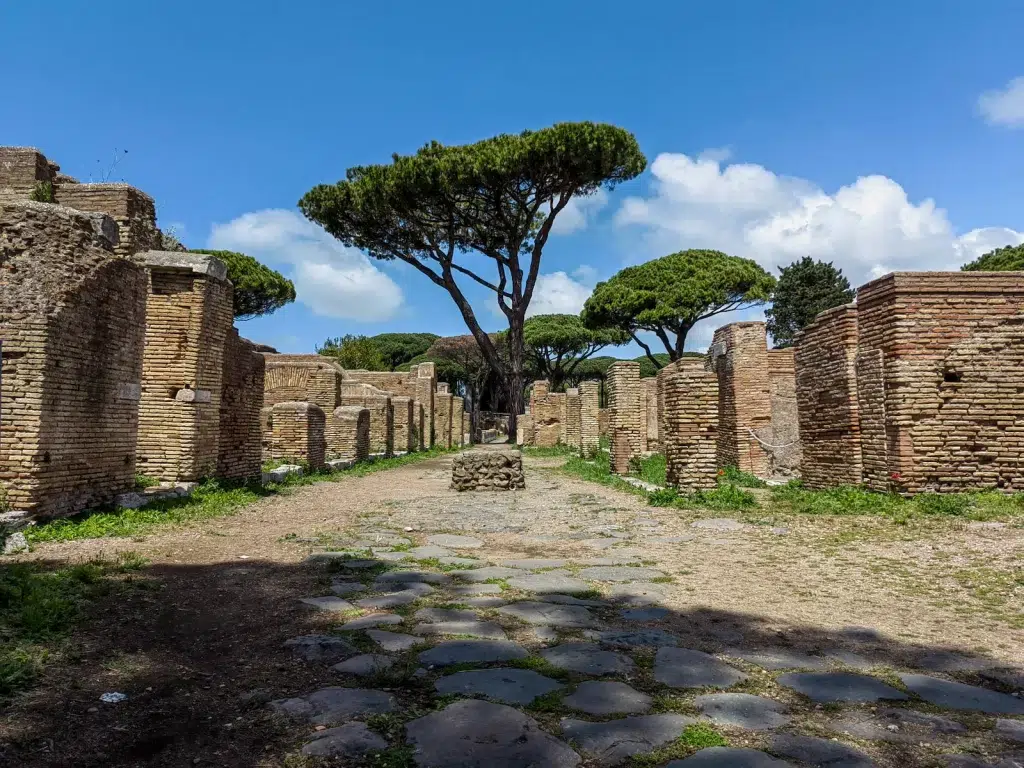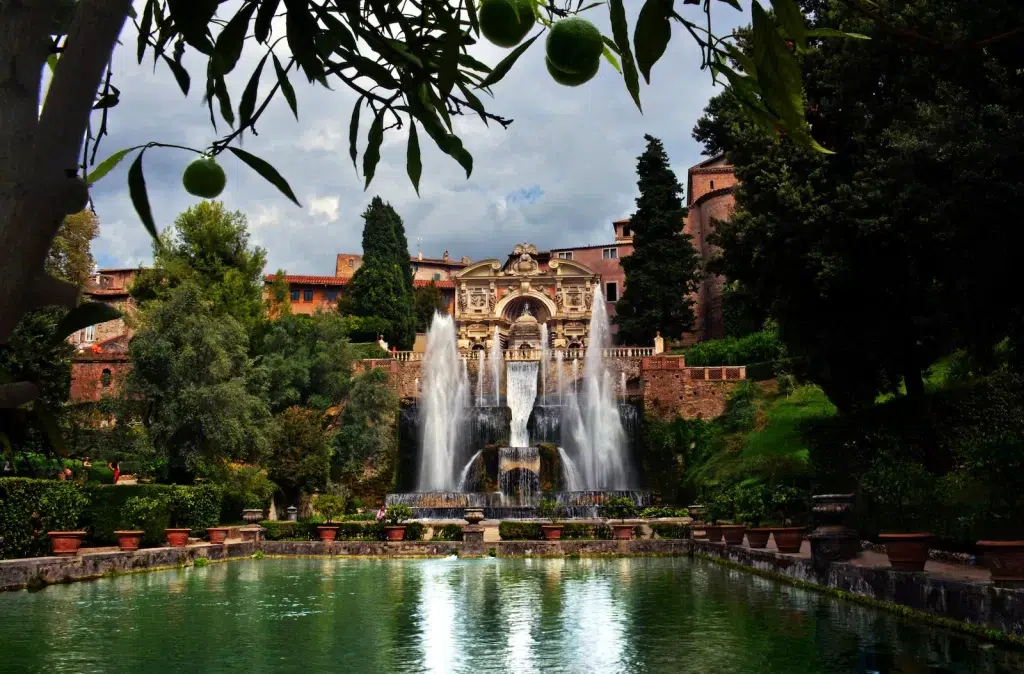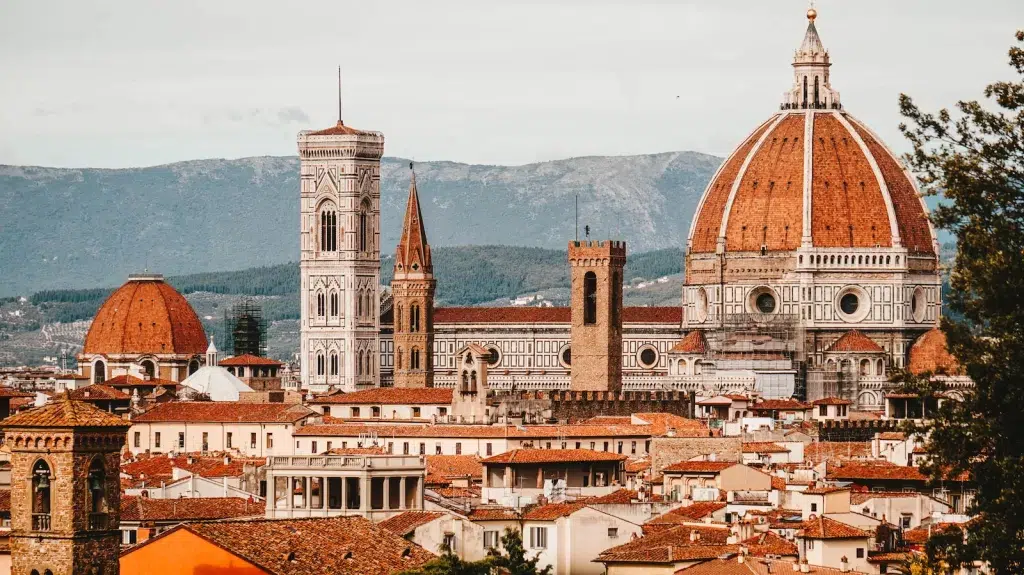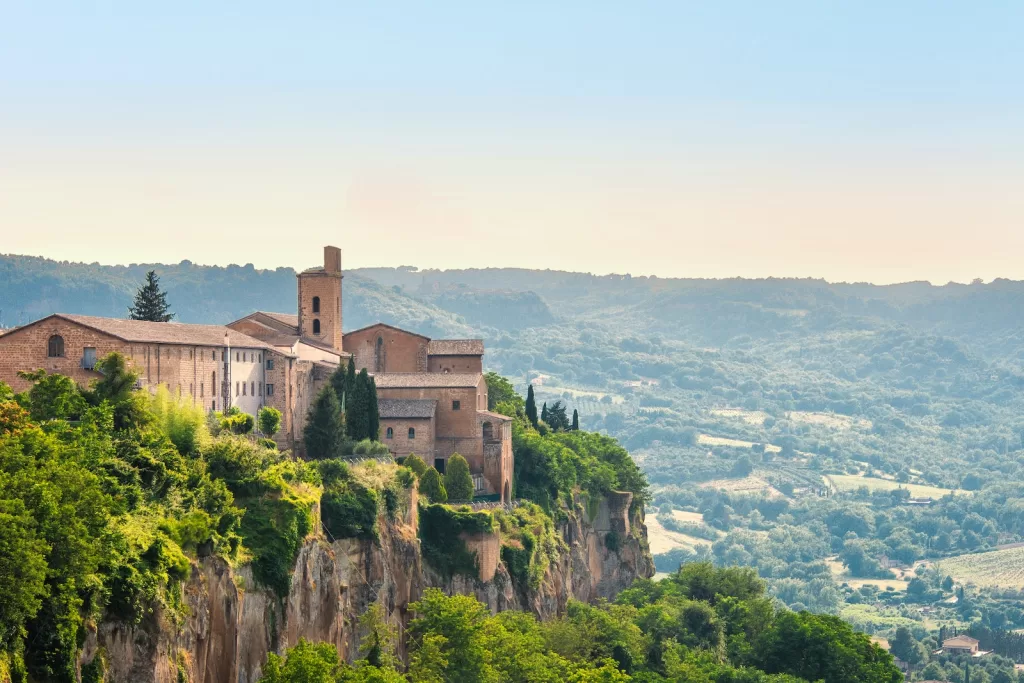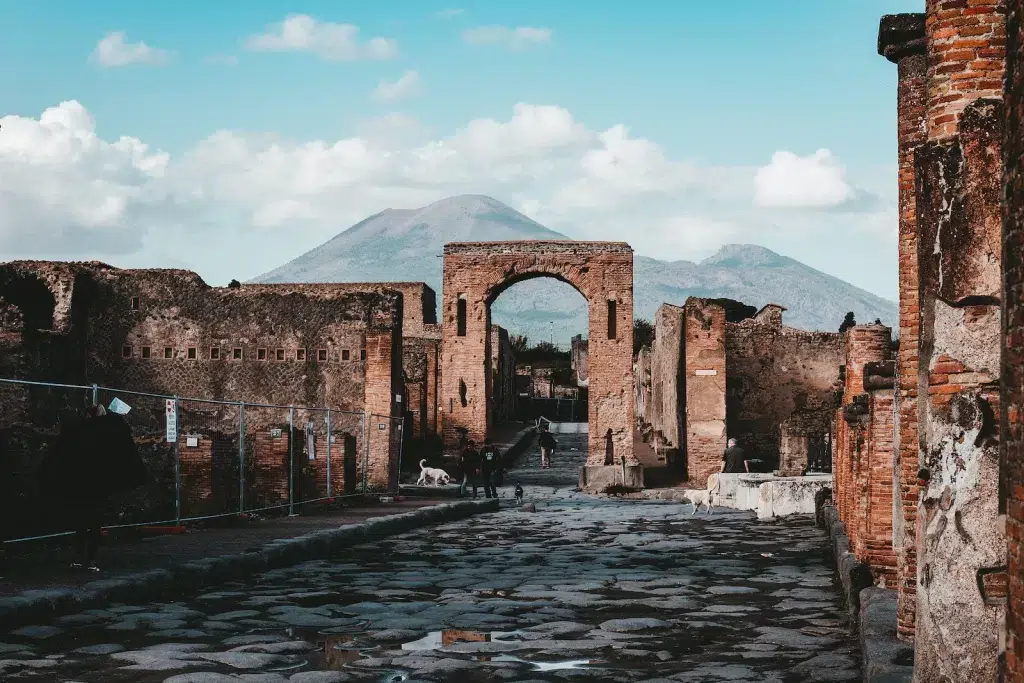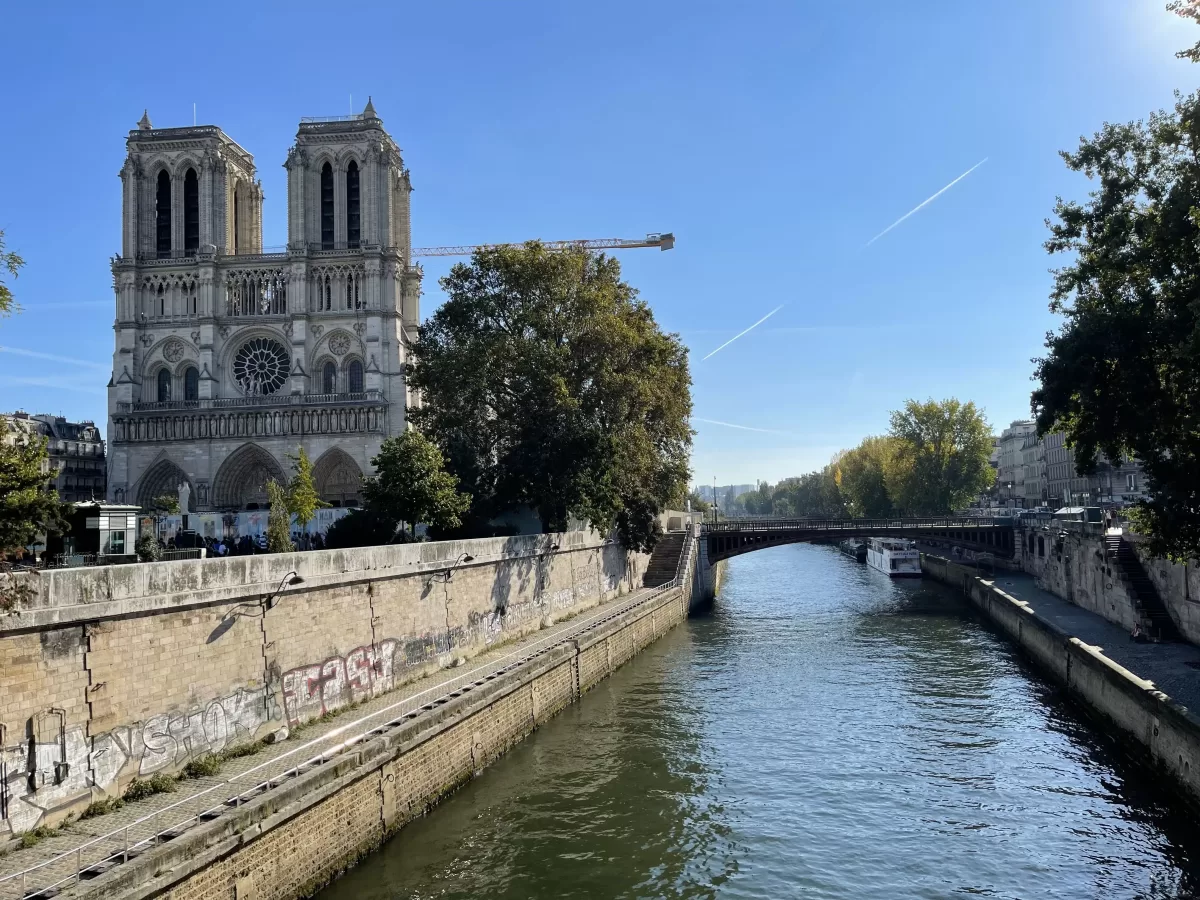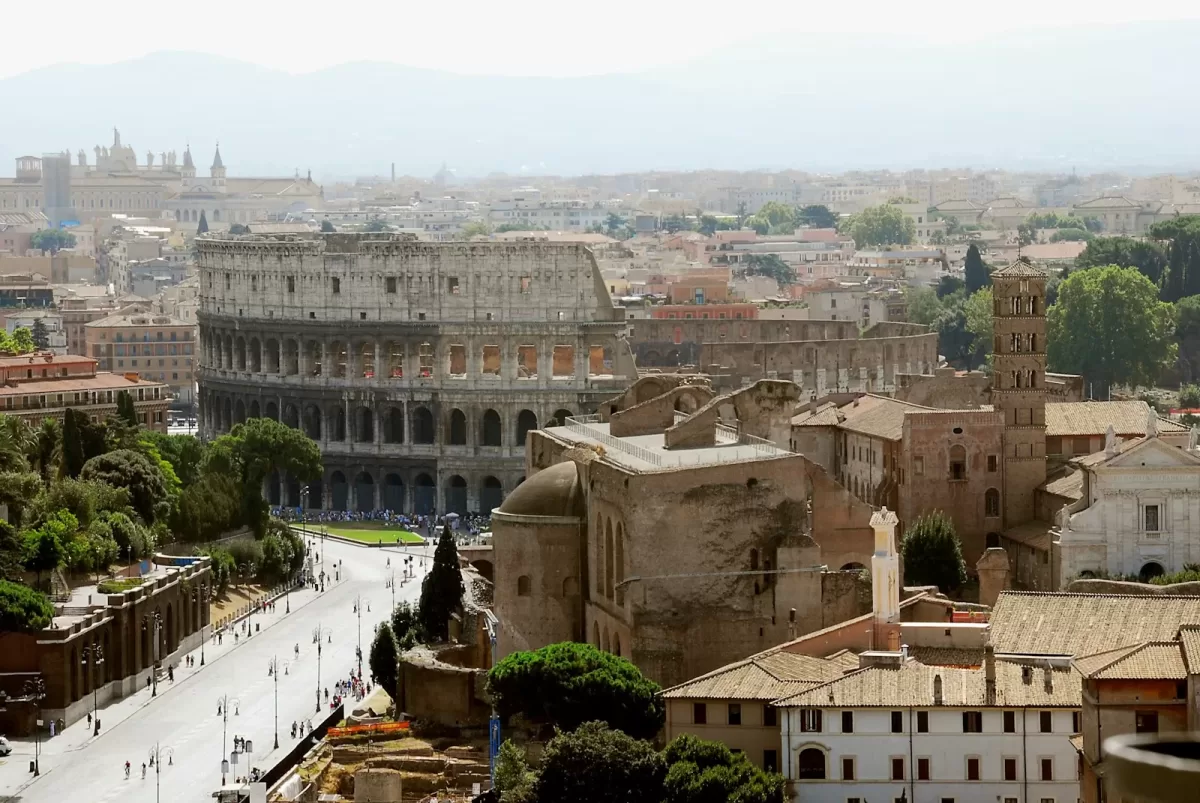16 Unforgettable Day Trips from Rome in Winter: A Guide
Dreaming of an Italian winter escape?
Well, why not dive deep into the heart of Italy when the weather gets colder? Trust me, the frost-kissed streets and chilly mornings bring out magic you won’t find in the summer heat.
In today’s post, I’m taking you on some unforgettable day trips from Rome in winter.
We all adore the Eternal City, and Rome is a great place to visit in the winter.
But let me spill a secret – the surrounding areas showcase a different side of Italian charm, often missed by those who stick solely to the capital.
Join me as we journey through picturesque towns, tranquil lakesides, and historic sites, all highlighting Italy’s winter glow.

Hey guys, This page contains affiliate links. If you click and purchase, I may receive a commission at no extra cost to you. I only recommend products I have personally vetted.
Winter in Rome and Italy
Now, if you’re picturing Rome blanketed in snow, let me pop that bubble.
Rome is more about soft winter sun and cool breezes than a winter wonderland.
With temperatures fluctuating between 4°C (39°F) and 15°C (59°F), it’s milder than more frigid counterparts of Northern Europe.
Though the snowflakes rarely grace Rome, the nearby Apennine mountains do have majestic snowy caps.
If you’re journeying north or to higher terrains, a sprinkle of snow can sometimes play spoilsport with your travel plans.
Occasional winter weather delays can influence where and how you get to your day trip destinations, and flexibility is key when planning your perfect day trips to areas outside of Rome.
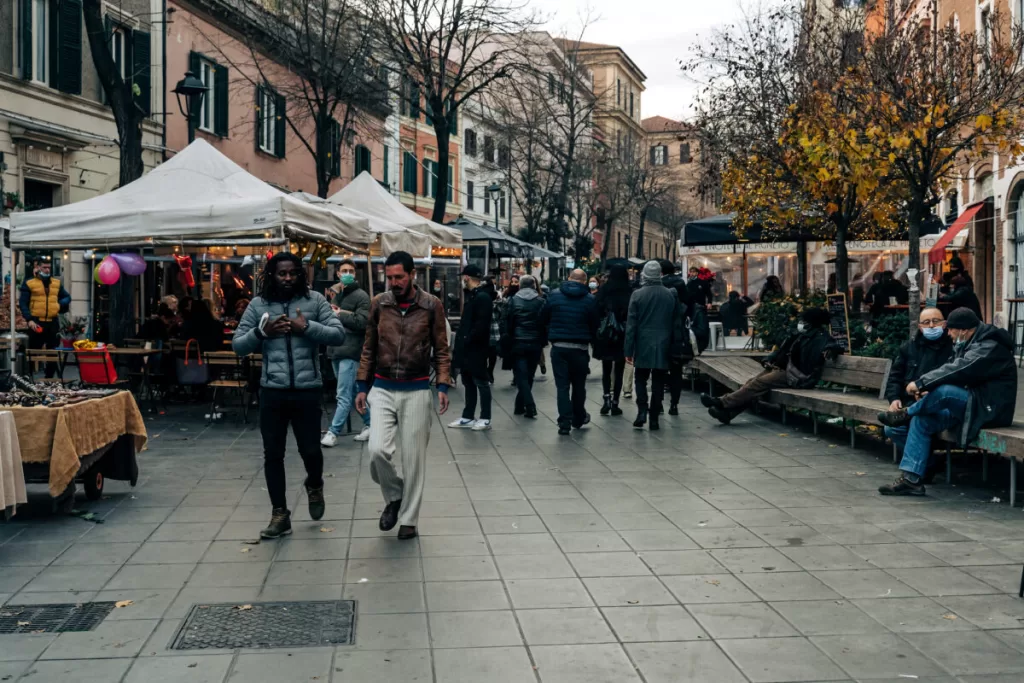
Packing for Rome and Surrounding Areas in Winter
Italian winters are all about layers, darling!
In Rome and most parts of Italy, think medium-weight coats, cozy sweaters, those cute scarves, and comfy walking shoes.
If your itinerary involves the northern regions or mountainous areas, heavier winter clothing, including a thick coat, gloves, and a hat, becomes essential.
Always keep an umbrella at hand, as winter can also bring sudden rain showers, especially in Rome.
In essence, winter in Italy is a blend of mild chilly breezes, occasional rain, and the rare, magical snowfall, making it a great time of year for exploration and discovery.
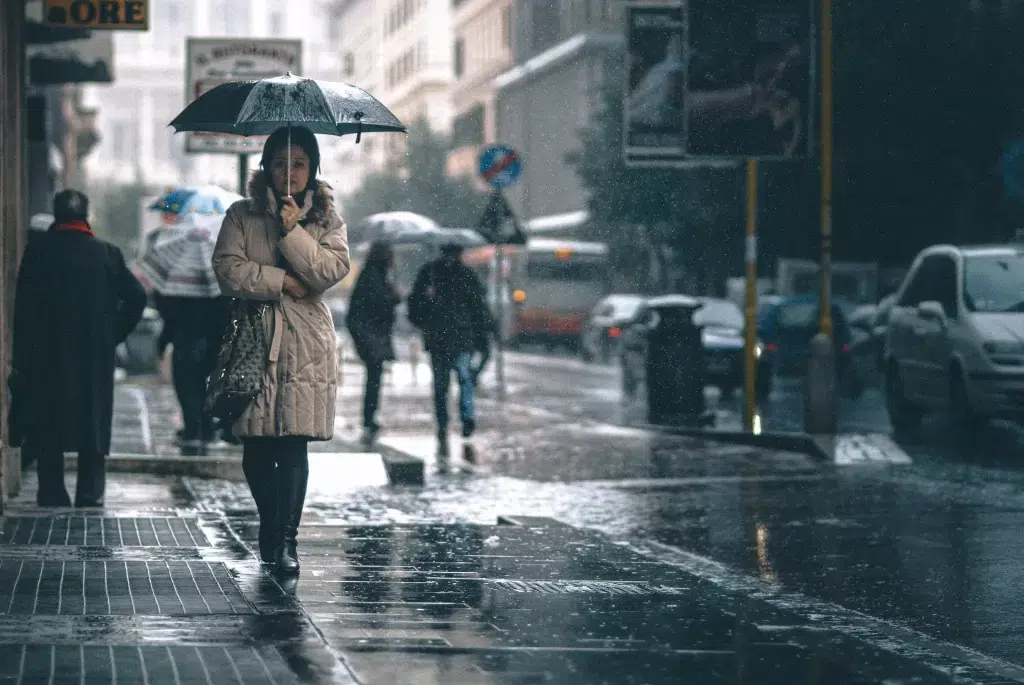
1. Ostia Antica:
How Far from Rome:
Just a hop, skip, and a 30 km jump from Rome, you’ll find Ostia Antica.
Once a bustling port during Rome’s heyday, today, it’s a quick escape from the capital’s hustle and bustle.
You will be transported to a world reminiscent of ancient times.
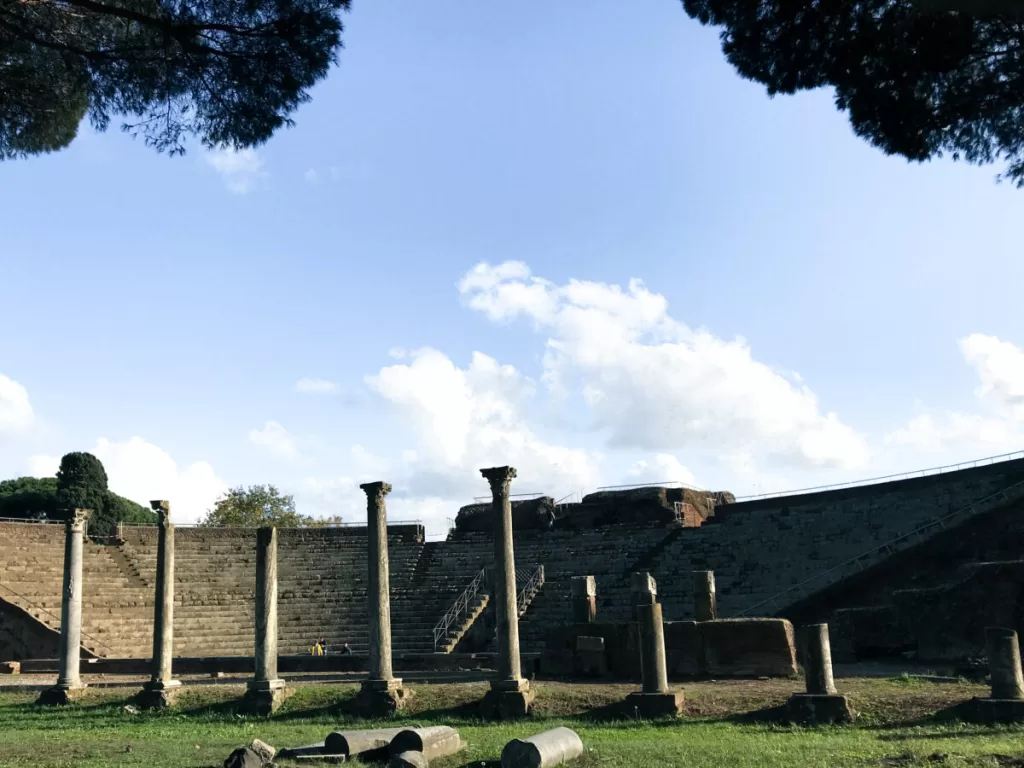
How to Get There from Rome:
Setting foot in Ostia Antica from Rome is remarkably easy. From the middle of Rome, take the metro to the Piramide stop (line B).
When you reach Piramide, transfer to the train station on the Roma-Ostia train (Line RL Cristoforo Colombo).
You get off at the seventh stop, ‘Ostia Antica’, after 27 minutes.
After a brief 5-minute stroll and voilà, you’re walking where Roman legends once did!
Things to See and Do:
Exploring Ostia Antica is like leafing through the pages of a living history book. It’s easy to picture yourself back in ancient times as you walk around the sites. :
- Grand Public Baths: These thermal baths, complete with intricate mosaic floors and towering columns, were once social hubs where Romans would converge for relaxation and gossip.
- Sprawling Apartment Complexes: Dubbed ‘insulae’, these ancient multi-storied structures provide a fascinating glimpse into the daily life of Roman citizens, where ground floors often served as shops and upper levels as residential quarters. Consider taking a guided tour for a more in-depth narration.
- Lavish Villas: The who’s who of ancient Rome lived it up here. Just check out those stunning frescoes and expansive courtyards!
- Ostia Antica Theatre: This was THE entertainment spot. From dramas to dances, this theater saw it all. And guess what? Its acoustics are still enjoyed today with modern-day shows that are continually held here year after year.
- Foro delle Corporazioni: The ancient Wall Street! Trades, deals, and perhaps some old-school networking went down here. Check out the mosaics and ancient inscriptions. They’re like the ancient emails and ads of the Roman Empire.
- Sacred Temples: Devote some time to explore the temples dedicated to Rome’s pantheon of gods and goddesses. Particularly, the Temple of Hercules and the Temple of Rome and Augustus offer architectural delights.
Why Winter is a Good Time to Go:
In winter, Ostia Antica is quiet and more relaxed.
The chill offers a quieter experience devoid of the typical tourist rush.
The silence helps you better imagine what life was like and who the people who once thrived in this town.
The reduced crowds mean you can take your time, unrushed, to absorb the history.
Just remember to pack your scarf.
2. Tivoli:
How Far from Rome:
Tucked away in the Roman hills, Tivoli is a mere 30 km jaunt to the northeast of Rome.
For centuries, this town has been the go-to escape for those needing a break from the city.

How to Get There from Rome:
Ready to escape the city noise? Hop on a regional train from Rome’s Tiburtina station.
Within a quick travel time of 40 minutes, Tivoli’s gentle hills and tranquil vibes will welcome you.
If you’re up for a more scenic journey, catch a bus from the Ponte Mammolo metro station and wind your way to this historic location.
Things to See and Do:
Tivoli is more than just a town; it’s a retreat from the business of Rome. Roman emperors built their massive villas here to rule Rome from the peace and quiet of the hills. It was their home away from home.
- Villa d’Este: An architectural and garden masterpiece of the Renaissance era, the villa is surrounded by terraced gardens and green landscapes. Its famed fountains (about 100 on the complex) are impressive. If the gardens are too cold to explore in the winter, check out the amazing villa estate that holds artwork. The detailed opulence in every room is breathtaking
- Hadrian’s Villa(Villa Adrianna): Dating back to the 2nd century AD, this 300-acre complex was Emperor Hadrian’s retreat. Wander through its ruins to discover ancient thermal baths, theaters, temples, and the iconic Maritime Theatre.
- Tivoli’s Old Town: Time travel through winding alleys, medieval homes, and quaint squares. Don’t forget to pop by the Cathedral of San Lorenzo and the ancient Temple of Vesta. Don’t forget to grab a heartwarming cappuccino at a local café – you’re on vacation, after all!
- Ponte Gregoriano: Besides offering a spectacular vantage point of the Acropolis, this bridge has seen its share of history. It was rebuilt after its WWII destruction. A true symbol of resilience!
Why Winter is a Good Time to Go:
Tivoli, in winter, is a scene straight out of a romantic Renaissance painting.
The sharp contrast of winter weather casts Villa d’Este and its fountains in a crystal shimmer.
The ruins of Hadrian’s Villa are dusted occasionally by frost, making the area feel more poetic.
The cooler temperatures mean fewer tourists, allowing you to meander through the area at a more relaxed pace.
As the winter sun sets over the Roman hills, Tivoli’s timeless charm is palpable, making winter an ideal time to visit.
3. Florence:
How Far from Rome:
Located roughly 280 km to the north of Rome, Florence, the capital of Tuscany, stands proudly on the banks of the Arno River.
It’s a city that feels like a living museum, with masterpieces at every turn.

How to Get There from Rome
Getting to Florence from Rome is a breeze!
The fastest route is the high-speed train, or Frecciarossa, departing from Roma Termini station and arriving at Florence’s Santa Maria Novella station in just 1.5 hours.
If you’re the kind who loves a road trip (who doesn’t?), rent a car and roll through Italy’s picturesque countryside. Trust me, the journey itself is as Instagram-worthy as Florence!
Things to See and Do:
Florence often hailed as the ‘Athens of the Middle Ages’, promises a feast for both the eyes and soul:
- Uffizi Gallery: Think of it as the VIP party of Renaissance art. Rub artistic shoulders with Botticelli, Michelangelo, and Leonardo da Vinci. Yep, they’re all here at one art gallery.
- Florence Cathedral (Duomo): With its iconic red-tiled dome, designed by Brunelleschi, this cathedral dominates the Florence skyline. Make the climb to the top, and you’re in for a treat with a killer view of the city.
- Ponte Vecchio: This medieval stone bridge, lined with shops and bustling with life, is emblematic of Florence’s charm. Perfect for those postcard-perfect snaps and sunset walks.
- Palazzo Vecchio and Piazza della Signoria: Florence’s town hall and the surrounding square form the political heart of the city. Also, say hi to the David statue replica while you’re there.
- Michelangelo’s David: Housed in the Accademia Gallery, Michelangelo’s David is waiting, and believe me, he’s worth the hype. This is a “must-do.”
Why Winter is a Good Time to Go:
Winter’s when Florence puts on a more intimate show. Less crowd, more “wow” moments on its historic streets and iconic spots.
The city’s artwork seems to pop more against winter’s crisp backdrop.
Florence’s cafés and eateries invite tourists to dine on hearty Tuscan meals.
While occasional snowfalls are rare, when they do occur, they transform Florence into a magical wonderland, with the Duomo and Ponte Vecchio draped in a blanket of white.
4. Naples:
How Far from Rome:
Just about 225 km southeast of Rome, Naples is a perfect day trip with its quirky mix of ancient charm and buzzing city life.
Let’s not forget the mighty Mount Vesuvius looming in the background, reminding everyone who’s the real boss around here.

How to Get There from Rome:
Want to get there quickly? Hop on the high-speed, fast train from Rome’s Termini station, and you’ll find yourself in Naples’ Central Station in just around 1 to 1.5 hours.
But if you’re in the mood for some scenic eye candy, hit the road! The journey will treat you to Italy’s changing landscapes, from winter fields to rugged coastlines.
Things to See and Do:
Exploring Naples promises an eclectic mix of historical wonders, gastronomic delights, and urban energy:
- Naples National Archaeological Museum: Imagine all the cool ancient antiques of Pompeii and Herculaneum under one roof. This place is like a treasure trove of Greco-Roman goodies.
- Castel dell’Ovo: Overlooking the Bay of Naples, this ancient fortress offers panoramic vistas of the city and the sea. Explore its chambers and corridors to learn about its maritime history and Naples’s past.
- Spaccanapoli: This narrow, bustling street cuts through the center of the historic center, and is filled with shops, eateries, and churches. It’s the essence of Neapolitan life condensed into one vibrant stretch.
- Naples Underground: Delve 40 meters below the city’s surface to explore a maze of ancient tunnels and chambers, some of which date back 2,400 years. It’s a journey through Naples’ layered history, from Greek foundations to wartime bunkers.
- Pizza Pilgrimage: Naples is the birthplace of pizza. It would be a mistake not to sample the authentic Neapolitan pizza in its hometown, with its soft crust, tangy tomatoes, and creamy mozzarella.
- Teatro di San Carlo: This isn’t just any opera house. It’s the granddaddy of them all. A treat for the eyes and ears. This is the world’s oldest opera house in continuous operation and is a mecca for music lovers
Why Winter is a Good Time to Go:
Winter in Naples is relatively mild.
The crowds thin out, meaning no elbowing your way through tourist hotspots.
The winter sunsets over the Bay of Naples are nothing short of spectacular.
With the cool air, you’ll have every excuse to sip on Naples’ rich coffee and nibble on those sinful pastries (sfogliatella, anyone?).
Festive Christmas events take place in the winter months with warmth and cheer. Sample foods like Struffoli, mustaccioli, susamielli, rococò.
5. Anzio
How Far from Rome:
Just a breezy 60 km south of Rome, the charming coastal city of Anzio is the perfect escape from city chaos.
It’s like taking a short vacation without really leaving home

How to Get There from Rome:
Easily accessible by train, one can embark from Rome’s Termini station and reach Anzio in just over an hour.
The journey unfolds with views of the Lazio countryside transitioning to ocean views.
For those who prefer the road, a scenic drive through the Roman countryside would get you there at about the same time.
Things to See and Do:
Anzio brims with historical significance as one of the most important battles during WWII.
- Beach Time: Let’s be honest; beaches are the stars here. Sure, winter might not be bikini weather, but a peaceful walk with the Tyrrhenian Sea beside you is the perfect way to spend a winter day.
- Roman Ruins in Anzio: Ever wondered how the Roman bigwigs chilled? Check out the remnants of Emperor Nero’s villa, complete with old-school mosaics and statues.
- Sicily-Rome American Cemetery in Nettuno: A solemn tribute to the valor of soldiers, this cemetery is the final resting place for thousands of American military personnel who lost their lives during World War II.
- The Port of Anzio: Historically significant, especially with its role in World War II, today it’s a bustling harbor filled with fishing boats, yachts, and waterfront restaurants.
- Foodie Alert: When in Anzio, eat as the locals do. Dive into some fresh fritto di paranza or warm up with a hearty seafood stew.
Why Winter is a Good Time to Go:
Winter along this stretch of the Italian coast brings a serene atmosphere, a stark contrast to the summer months when both towns become popular local getaways.
The cool, crisp air makes beach walks invigorating. Too cold for a swim? No worries! The views alone, with the shimmering sea and the soft winter light, are worth it.
The best part? You get to savor the local vibes, food, and history at your own pace,
The reduced number of visitors means that the local eateries, landmarks, and beaches can be enjoyed without the summer hustle.
Additionally, the historical cemetery, in the quiet of winter, allows for reflective exploration.
6. Castelli Romani:
How Far from Rome:
Located just 20-30 km from Rome’s city center, the Castelli Romani comprises of about a dozen scenic towns perched atop volcanic hills.
Think of this area as Rome’s laid-back, rustic cousin, a blend of the great outdoors with a splash of culture.

How to Get There from Rome:
The Castelli Romani is easily accessible by train from Rome.
Depending on which specific town you aim to visit, it’s a swift 30-45 minute train ride.
Trains frequently depart from Rome’s Termini or Tuscolana stations heading towards the Castelli Romani, making it a convenient day trip option.
Things to See and Do:
The Castelli Romani brims with unique experiences, set against a backdrop of verdant landscapes and historical marvels:
- Wine Tasting: The region is renowned for its wine culture. This place is wine heaven. Rows of vineyards, rustic cellars, and the star of the show – the crisp, white Frascati. When in Castelli Romani, sipping is a must!
- Lake Albano: This serene volcanic lake offers picturesque views and is surrounded by winter greenery. Winter or not, it’s always a good place to take a stroll.
- Pope’s Summer Residence in Castel Gandolfo: Castel Gandolfo, right above Lake Albano, isn’t just any summer house – it’s THE summer house for popes! And guess what? Since 2016, Pope Francis opened it for us ordinary folk too. It’s all grandeur and history inside.
- Explore the Towns: Each town in the Castelli Romani has its own charm. From the medieval allure of Rocca di Papa to the Renaissance beauty of Frascati, there’s a variety of architecture, culture, and history to uncover.
- Local Cuisine: Apart from wines, the region offers yummy dishes, often using fresh, local produce. Savor specialties like porchetta (roast pork) or indulge in a variety of rustic loaves of bread and cheeses.
Why Winter is a Good Time to Go:
In winter, the Castelli Romani is known for its coziness and rustic charm.
The chill in the air highlights the warmth of the local wines and hearty meals.
There’s a possibility of snow, which makes vineyards, ancient villas, and narrow town alleys look like scenes from a classic European postcard.
It’s a time when the region’s natural beauty and rich history can be savored without the buzz of peak tourist season, making it a dreamy winter escape just a stone’s throw from Rome.
7. Orvieto
How Far from Rome:
Approximately 120 km north of Rome, the ancient town of Orvieto looms from atop a massive bedrock of volcanic stone.
If you’re hunting for epic views, a deep dive into the past, and a taste of authentic Italy, you’ve found your spot.
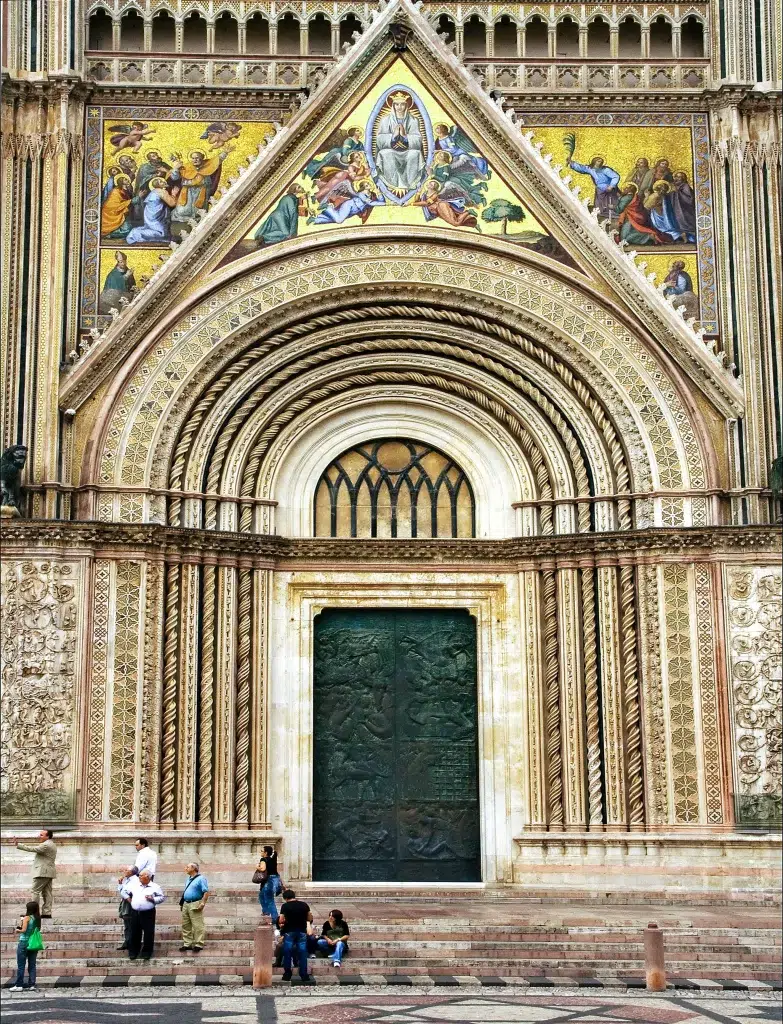
How to Get There from Rome:
Orvieto is one of the best places to visit near Rome by train.
Departing from Rome’s Termini station, you’ll find yourself stepping into Orvieto in just about an hour.
The train journey, traversing the gorgeous Italian countryside, sets the stage for the beauty and charm that Orvieto promises.
Things to See and Do:
Orvieto invites you to explore a range of experiences that seamlessly blend history with beauty.
- Orvieto Cathedral (Duomo di Orvieto): A masterpiece of Gothic architecture, this cathedral is renowned for its dazzling façade adorned with mosaics, sculptures, and spires.
- Underground Orvieto: Beneath the town lies a labyrinth of tunnels, galleries, wells, and caves. Orvieto’s got secrets! Check out the wild maze of tunnels, wells, and even an ancient olive mill. Perfect for those who love a hint of mystery.
- Taste Local White Wines: The volcanic soil around Orvieto makes it prime territory for winemaking. The local white wines are crisp, aromatic, and best enjoyed with the town’s traditional dishes. P.S: Grab a bottle of Orvieto Classico and thank me later.
- Pozzo di San Patrizio (St. Patrick’s Well): A marvel of engineering, this historic well is not the usual tourist pit stop. It’s deep (like 53 meters deep), and includes a double spiral staircase to ascend and descend the space. Ingenious!
- Art and Craft Shops: Orvieto boasts a rich tradition of arts and crafts, particularly ceramics. Wandering its cobblestone streets, you’ll come across numerous studios and shops showcasing intricate pottery, textiles, and other local crafts.
Why Winter is a Good Time to Go:
The cooler months often see the Umbrian countryside and the town’s majestic cliffs covered in misty air and fog.
This can add an air of mystery and charm to its historic structures and winding streets.
Wintertime turns Orvieto into a quiet haven of medieval beauty.
Cozy up in a corner eatery, sip on that lovely white wine, and just soak in Orvieto’s heartwarming winter vibe.
Winter in Orvieto is less about the bustle and more about enjoying the town’s soulful atmosphere.
8. Sperlonga:
How Far from Rome:
Have you ever had that daydream of a perfect little coastal town? Sperlonga’s got you covered, situated around 120 km southeast of Rome.
The beauty pops with its Grecian-style white buildings against the stunning blue of the Tyrrhenian Sea. Honestly, one look and you’d think you teleported to Greece!
Known for its jaw-dropping views, Sperlonga’s got more than just good looks – there’s a bunch of history tucked in there too.
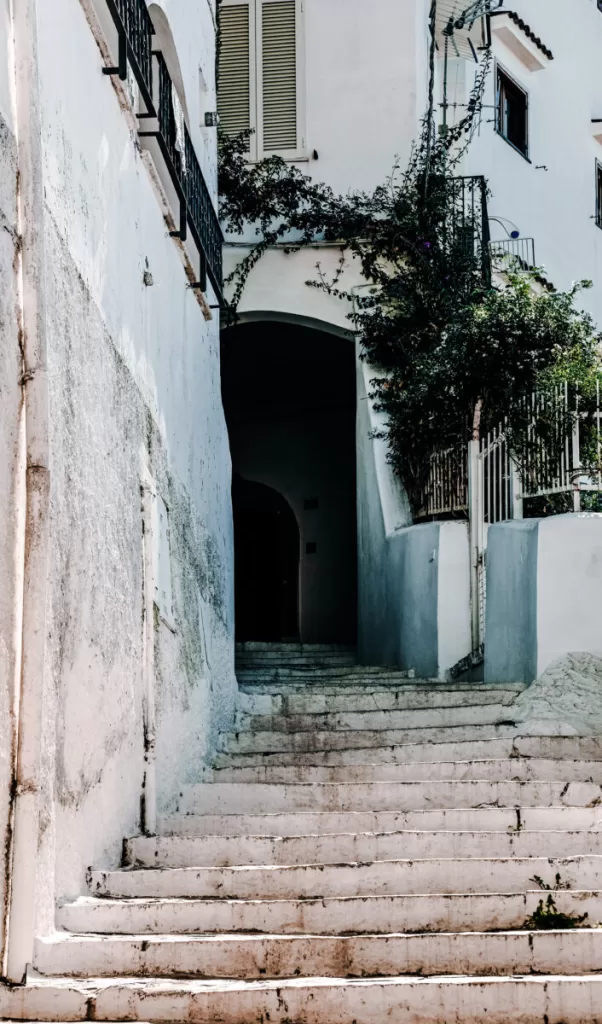
How to Get There from Rome:
Alright, here’s the game plan. From Rome’s Termini station, hop on a train headed to Fondi-Sperlonga.
It’s a 1-1.5-hour journey. Once you hit Fondi station, it’s a quick 15-minute bus or taxi drive straight to Sperlonga.
If you ask me, I would rent a car for maximum convenience. Trust me, the drive’s part of the adventure.
Things to See and Do:
- Wander Through the Streets: Get lost (in a good way) in Sperlonga’s maze of picturesque alleys. Every corner’s got its own story – and is pretty much begging for a selfie.
- Archaeological Museum: The National Archaeological Museum of Sperlonga shelters some of the town’s most significant discoveries. It’s home to sculptures depicting scenes from the Odyssey, recovered from the nearby grotto of Emperor Tiberius.
- Grotto of Tiberius: Once a swanky part of Emperor Tiberius’s holiday house. This spot’s where those sculptures from the museum were dug up back in ’57
- Seaside Views: Grab a gelato and find a spot to take in the killer views of the Tyrrhenian Sea. Even in the chillier months, the beaches are a great place to relax and take in the quiet winter atmosphere.
- Foodie Alert: Being seaside means one thing: insanely fresh seafood. Hit up the local joints, snag some fish dishes, and wash it down with the local wines.
Why Winter is a Good Time to Go:
Sperlonga, in winter, transforms into a serene coastal sanctuary.
The summer crowds have dissipated, leaving a chilled-out coastal vibe. The cool sea breezes create an atmosphere of peaceful rejuvenation.
As you stroll through the town’s alleys or sit by its shores, the town’s whitewashed facades glow.
The sound of the waves is more pronounced in the silence of winter, and it is so peaceful.
9. Pompeii:
How Far from Rome:
Situated about 230 km (143 miles) to the south of Rome, Pompeii provides a snapshot of what Roman life was like in ancient times.
Once a thriving Roman city, Pompeii’s life came to a dramatic halt in 79 AD, when the nearby Mount Vesuvius erupted and buried it under a thick blanket of volcanic ash.
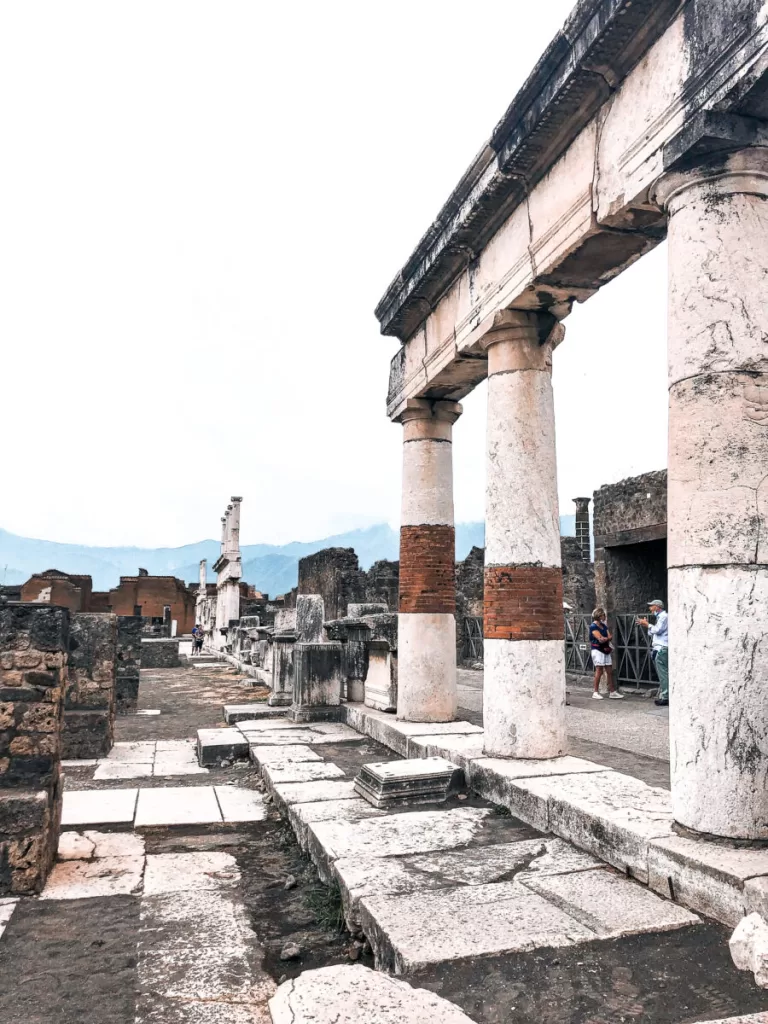
How to Get There from Rome:
Reaching Pompeii from Rome is straightforward.
The most convenient way is to take a high-speed train from Rome to Naples, which takes just over an hour.
From Naples, the Circumvesuviana railway will transport you to Pompeii in about 30 minutes.
The Pompeii Scavi – Villa dei Misteri train station is just outside the archaeological site, making access easy.
Things to See and Do:
Pompeii’s expansive archaeological site offers a haunting yet fascinating dive into the ancient world:
- Archaeological Excavations: Walk through the ancient streets of Pompeii and discover remnants of homes, shops, and public spaces. The city’s layout is remarkably intact, giving a real sense of the day-to-day life of its inhabitants.
- The Forum: Think of it as Pompeii’s Times Square. This was the heart of all action, be it religious, political, or a simple market day.
- Homely Tales: Explore places like the House of the Faun or the House of the Tragic Poet. It’s like peeping into Pompeii’s personal tragic photo album, giving more insight on the day-to-day activities of the former residents.
- Amphitheater of Pompeii: As one of the oldest known Roman amphitheaters, this structure could accommodate up to 20,000 spectators. Ancient Romans sure knew how to entertain. This massive structure was their spot for all the action
- Lupanar: Now, this is spicy! Pompeii’s famous brothel is, let’s just say, very illustrative about its offerings. Its walls are adorned with explicit frescoes that serve as a menu for clients.
- Plaster Casts: These are molds of the voids left by the decayed bodies of Pompeii’s residents and are one of the most haunting sights and reveal their final moments. Literally capturing the city’s last moments, these molds are a heart-tugging sight.
Why Winter is a Good Time to Go:
Pompeii in winter? Game-changer. Forget roasting in the summer sun.
Instead, you can explore the ruins at a leisurely pace without the discomfort of extreme heat. The cooler temperatures provide an environment for prolonged exploration.
Moreover, winter sees a reduction in tourist numbers which means no jostling or waiting for that perfect photo spot.
10. Tuscany:
How Far from Rome:
Starting roughly 270 km from Rome and sprawling northwards, Tuscany is Italy’s poster child for beauty and culture.
Renowned for its iconic landscapes, historic towns, and rich cultural heritage, Tuscany is usually on most tourists’ bucket lists.
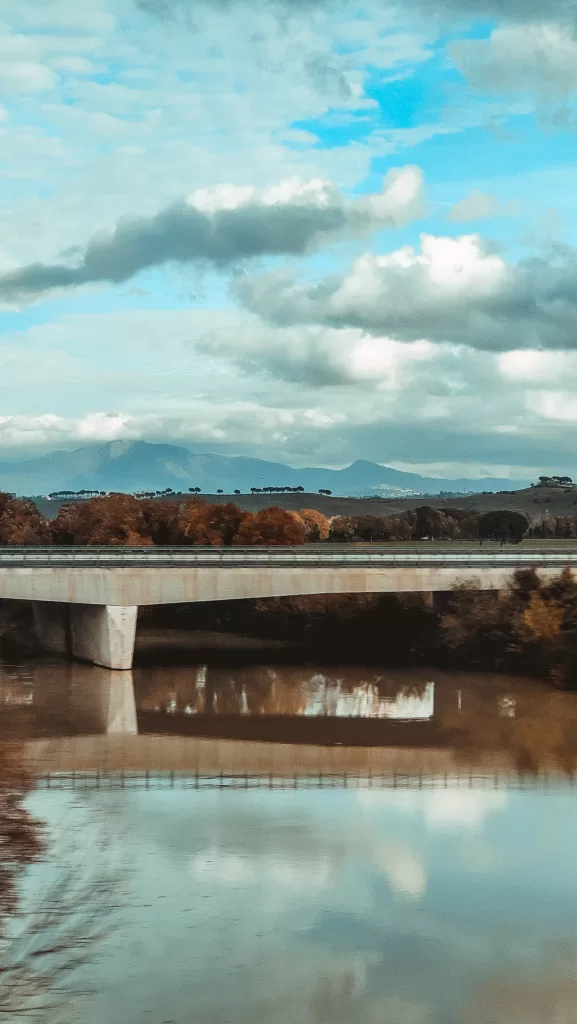
How to Get There from Rome:
Tuscany is well-connected by rail and road from Rome.
The primary gateway city, Florence (or as the locals call it, Firenze), can be reached in about 1.5 hours by high-speed trains from Rome’s Termini station.
For a broader exploration of Tuscany, renting a car would be ideal, allowing you to meander through its vineyard-laden countryside at your own pace.
Things to See and Do:
The allure of Tuscany is diverse, offering something for history buffs, wine lovers, art enthusiasts, and those simply in search of scenic beauty:
- Siena: Renowned for its medieval brick buildings and the Piazza del Campo, the venue for the famous Palio horse race, Siena offers a perfect location for a Tuscan day trip.
- Chianti Wine Region: A haven for wine lovers. Rows upon rows of vineyards, welcoming wineries, and glasses filled with the finest reds.
- Val d’Orcia: A UNESCO World Heritage site, this area of Tuscany features rolling hills, iconic cypress trees lining the roads, and homes that look straight out of a painting.
- Lucca: Encircled by well-preserved Renaissance walls, Lucca boasts of historic alleyways, stunning palaces, and a vibe that’s unmistakably Tuscan.
Why Winter is a Good Time to Go:
In the winter, you will get a more authentic vibe from Tuscany.
Walking through the historic streets of Siena without the summer crowds allows for a deeper connection with the region’s soul.
The winter chill makes it all the more appealing to cozy up in a local trattoria, savoring a hearty Tuscan dinner accompanied by world-class wines.
Leafless vineyards present a different kind of beauty, stark against the winter sky and occasionally dusted with snow.
Moreover, many local festivals and events take place in winter, offering insights into the region’s traditions and customs.
Winter in Tuscany is a time of beauty and authenticity, showcasing its genuine, timeless charm.
11. Calcata:
How Far from Rome:
Just a stone’s throw away from Rome (well, about 47 km north!), Calcata isn’t your usual Italian hot spot.
Tucked away in the Lazio region, it’s a delightful detour from the usual tourist hot spots.
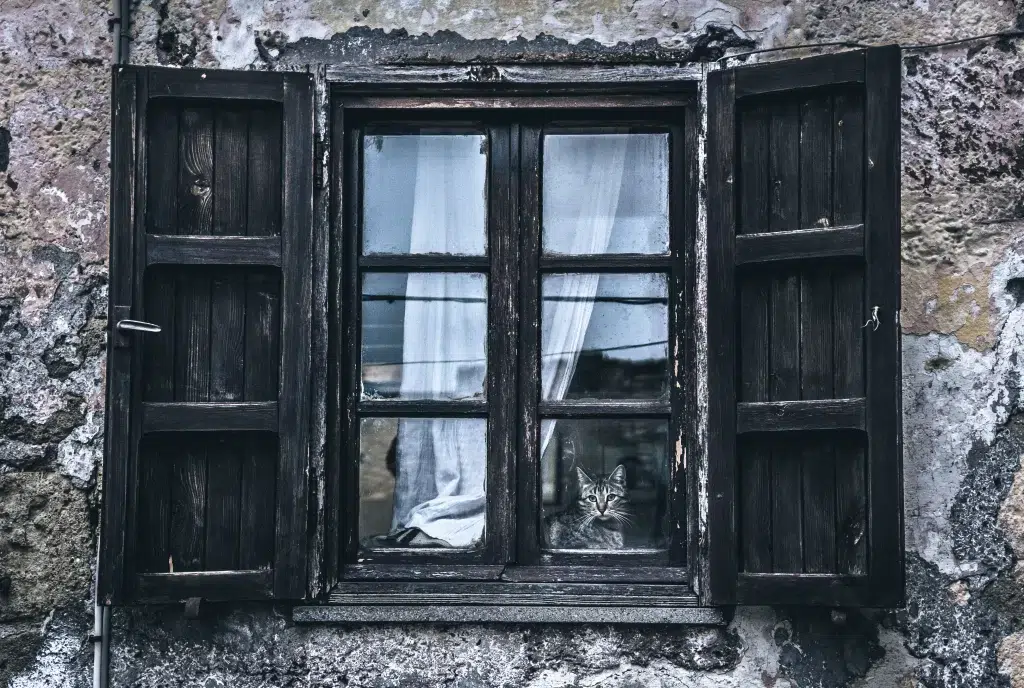
How to Get There from Rome:
Getting to Calcata requires a bit of a scenic journey.
There isn’t a direct train line to this quaint village, so the best way to reach Calcata from Rome is by car.
The drive typically takes about an hour, winding through the picturesque Italian countryside and offering the freedom to explore at your own leisure.
Things to See and Do:
This medieval village, with its bohemian vibes and artistic soul, offers a plethora of unique experiences:
- Meander the Cobbled Streets: At the heart of Calcata’s charm are its narrow, winding streets, each turn revealing charming old houses, hidden courtyards, or panoramic views of the surrounding Treja Valley.
- Art Galleries and Studios: Over the years, Calcata has become a magnet for artists. As you wander around, you’ll stumble upon studios and galleries, often with artists lost in their craft. Maybe even snag a local masterpiece for your living room?
- Treja Valley Regional Park: Just beyond Calcata, this park is a natural oasis, home to unique landscapes and crisscrossed by hiking trails that provide breathtaking vistas. It’s an open invitation to all nature lover
- Local Cafes and Eateries: Being a hub for artists and bohemians, Calcata’s cafes are, expectedly, vibrant and quirky. Enjoy a coffee or a local dish while soaking in the village’s unique atmosphere.
Why Winter is a Good Time to Go:
There’s something about Calcata in winter—the cold seems to hug the ancient stones a bit tighter, and because the winter crowd is thinner, you can soak up Calcata’s artsy vibe in peace.
The cafes? They’re more than just food joints. They’re cozy little nooks of warmth and cheer.
Occasionally, a light drizzle might grace the village, making the streets glisten and enhancing the smell of the surrounding wooded forests.
12. Pisa:
How Far from Rome:
Pisa, one of Tuscany’s shining jewels, is situated approximately 350 km (about 217 miles) northwest of Rome.
Pisa isn’t just about that quirky tilted tower! Pisa is like that cool cousin with a fun secret.
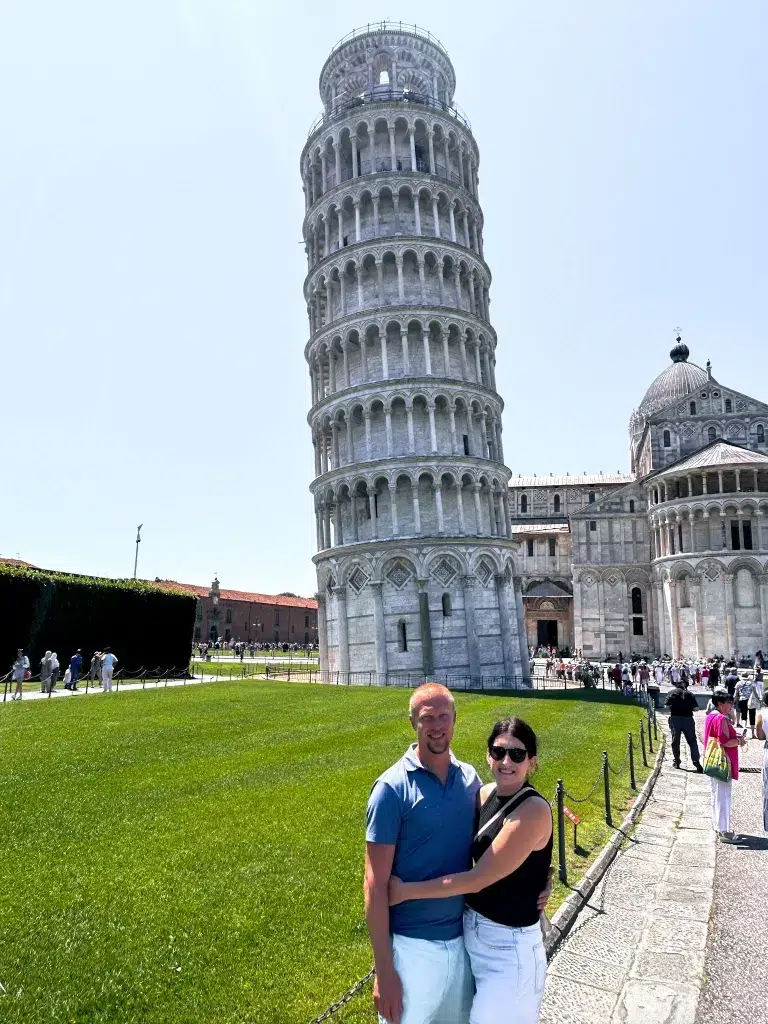
How to Get There from Rome:
Pisa is well-connected to Rome by both rail and road.
The easiest way to reach Pisa is by taking a high-speed, fast train from Rome’s Termini station.
The journey typically lasts around 2.5 to 3 hours, making it a feasible day trip or an excellent overnight destination.
Things to See and Do:
While the Leaning Tower might be Pisa’s most famous attraction, the city boasts a rich tapestry of history, art, and culture:
- The Legendary Leaning Tower: It’s iconic. It’s quirky. And yes, it leans! Situated in the Piazza dei Miracoli, the tower offers a bird’s eye view of Pisa. If you’re up for it, take on the lean and head to the top.
- Piazza dei Miracoli: Apart from the leaning tower, this UNESCO World Heritage site hosts the impressive Pisa Cathedral, the Baptistery, and the Camposanto Monumentale – each an architectural masterpiece in its own right.
- Museo Nazionale di San Matteo: Dive deep into Tuscan art and history in this museum, home to an impressive collection of sculptures, paintings, and artifacts.
- Palazzo della Carovana: With its ornate façade, this palace is the main building of the Scuola Normale Superiore di Pisa, one of the best universities in all of Italy. The building is an architect’s or a photographer’s dream.
- Arno River and its Bridges: A stroll along the Arno, especially during sunset, is a serene experience. The historic bridges, such as Ponte di Mezzo, offer lovely vantage points.
Why Winter is a Good Time to Go:
The shorter days mean that landmarks, like the Piazza dei Miracoli, are bathed in a golden hue for longer, creating a dreamy light perfect for photography.
The crisp Tuscan winter air makes wandering the streets a delight, as you meander from historic site to cozy café, sipping on a piping hot cappuccino or indulging in seasonal Tuscan treats.
The often-clear winter skies provide a striking backdrop for the Leaning Tower and other historic structures, making them stand out even more prominently.
Additionally, the festive season brings with it local markets, lights, and celebrations, imbuing the city with a celebratory spirit.
13. Bomarzo:
How Far from Rome
Ever heard of Bomarzo? It’s this little gem in the province of Viterbo, roughly 90 km (or about 56 miles) north of Rome. For the
Those itching to do something offbeat, Bomarzo is your ticket to one of the quirkiest adventures just outside Rome.
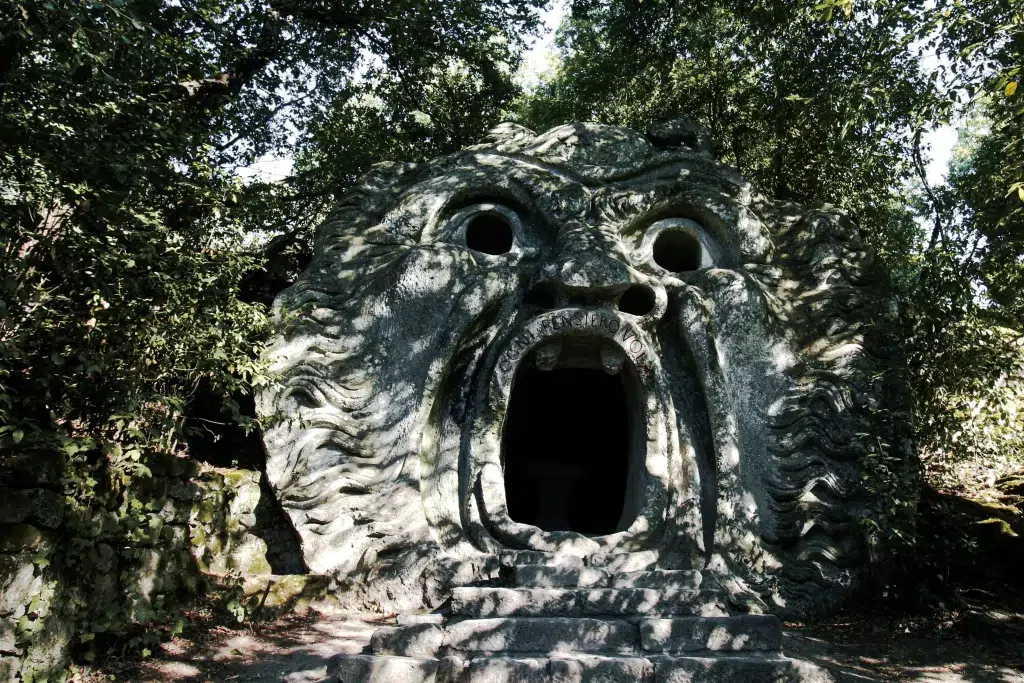
How to Get There from Rome:
While you could juggle trains and buses, the smoothest ride to Bomarzo is by car.
In about 1.5 hours, you’ll roll into town, ready to explore. Having a car lets you roam according to your own schedule.
Things to See and Do:
Bomarzo might be a small town, but it offers an experience unlike any other, primarily centered around its renowned park:
- Parco dei Mostri (Park of the Monsters): Ever been to a garden that feels like a trip through someone’s imagination? This is it! Commissioned by Prince Orsini in the 16th century as a form of personal catharsis after experiencing war and personal loss, this garden is unlike any traditional European garden. It’s a mix between art and a personal diary, filled with enormous and sometimes eerie stone sculptures of creatures, mythical beasts, and odd structures.
- Bomarzo Historical Center: Wander the streets of this medieval town, with its stone houses, narrow alleyways, and historic churches, offering a quiet contrast to the crazy park.
- Castle of Bomarzo: Though now a private residence, the exterior of this historical castle is impressive. Castles are always interesting so be sure to get a picture of this one.
Why Winter is a Good Time to Go:
Bomarzo, especially its Park of the Monsters, takes on a unique perspective in winter.
The cooler months give the stone sculptures an even more surreal and mysterious atmosphere.
The chill in the air, occasional frost, and the barren trees often enhance the dramatic effect of the sculptures, making your journey through the park feel like a wander through a frozen storybook.
Plus, fewer tourists mean you get this quirky place pretty much to yourself.
14. Viterbo:
How Far from Rome:
Not far from the busy life of Rome, you’ll find Viterbo.
Just 80 km (or about 50 miles) north, it’s a city tucked among Lazio’s gentle, rolling hills.
It’s where popes used to hang out when they needed a retreat from Rome!
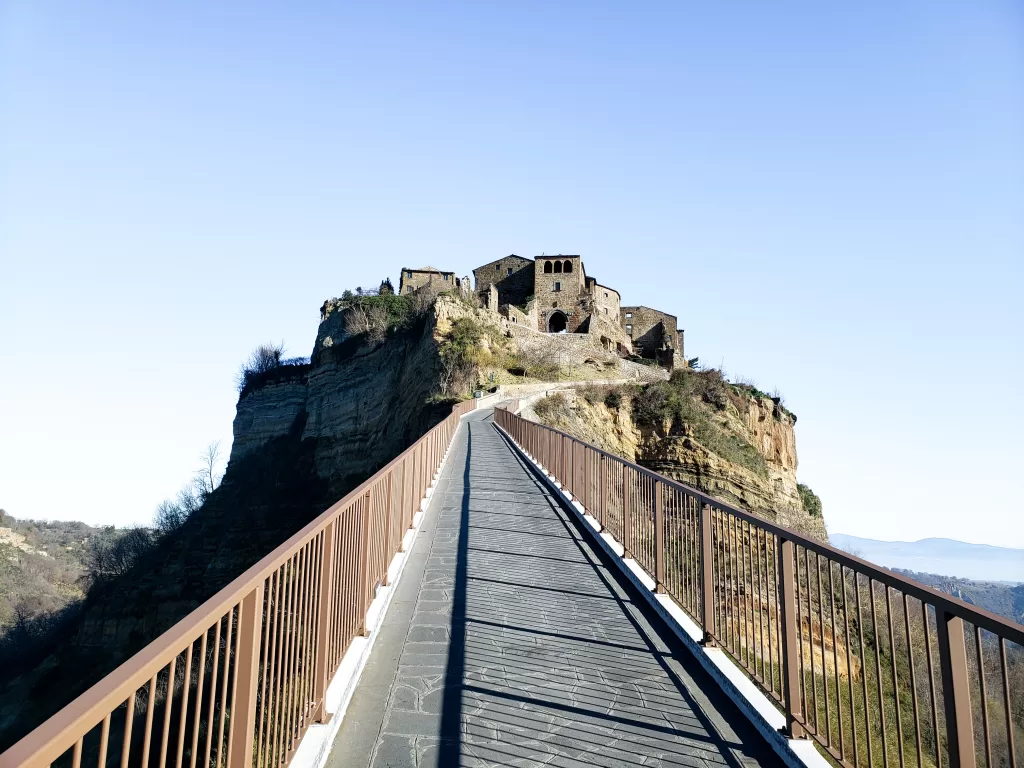
How to Get There from Rome:
Easily accessible from Italy’s capital, Viterbo can be reached by train in under two hours from Rome’s Termini or Tiburtina stations.
For those preferring the flexibility of road trips, a drive through Lazio’s picturesque countryside takes roughly the same amount of time.
Things to See and Do:
Viterbo’s rich tapestry of history unfolds in its well-preserved medieval structures and winding lanes:
- Palazzo dei Papi: This impressive structure was where popes escaped to way back in 1257 because Rome was getting a bit too chaotic and violent. The highlights are Its Gothic façade and the magnificent loggia where the popes once blessed the crowds.
- Medieval Quarter: Stroll through the San Pellegrino district, one of the best-preserved medieval neighborhoods in Italy. Its narrow streets, arches, and historic homes transport visitors back to the Middle Ages.
- Baths of Viterbo: Viterbo is renowned for its natural hot springs, many of which have therapeutic properties. The Bullicame spring, mentioned by Dante in his Divine Comedy, is just one of the several thermal spots where visitors can relax.
- Viterbo Cathedral: Located in the city’s heart, this Romanesque-style cathedral, with its plain façade, is perfect for history and architecture lovers. The cathedral was directly hit by a bomb in 1944, and the restoration that has gone into the church is impressive.
Why Winter is a Good Time to Go:
There’s something about Viterbo in winter.
The chill of winter provides the perfect excuse to indulge in Viterbo’s famed hot springs, offering relaxation and a chance to rejuvenate.
Add to this the festive buzz during Christmas and New Year, and you’ve got a winter wonderland and a perfect way to spend a day outside of Rome.
15. Assisi:
How Far from Rome:
Resting peacefully on the slopes of Mount Subasio, Assisi is approximately 185 km (around 115 miles) north of Rome.
This UNESCO World Heritage site is not just a city; it’s a spiritual sanctuary, drawing pilgrims and tourists alike with its storied past.

How to Get There from Rome:
Assisi is well-connected to Rome by both rail and road.
A direct train from Rome’s Termini station to Assisi will take about 2 to 2.5 hours.
If you opt for a road journey, the scenic drive through the heart of the Umbrian countryside takes roughly the same amount of time.
Things to See and Do:
Assisi, the birthplace of St. Francis, is brimming with rich history, art, and spirituality:
- Basilica of St. Francis: A masterpiece of medieval art and architecture, this basilica is a two-level church adorned with frescoes by renowned artists like Giotto and Cimabue. It also is the resting place of St. Francis himself.
- Rocca Maggiore: For those “top of the world” feels and unbeatable views of Assisi and the Umbrian countryside, this castle’s where you’ll want to be.
- Basilica of Santa Chiara: A tribute to St. Clare, it’s pink, it’s white, it’s historic, and it’s where you can share a quiet moment with the saint herself..
- Piazza del Comune: Assisi’s main square is a bustling hub surrounded by historic buildings and landmarks. Perfect for a coffee or some people-watching.
Why Winter is a Good Time to Go:
The cool, crisp air makes for refreshing strolls along the cobblestone streets, and the low winter sun casts a soft golden hue over the town’s iconic pink stone buildings.
Snow-capped peaks of Mount Subasio serve as a stunning backdrop, especially when viewed from the Rocca Maggiore.
Moreover, Christmas in Assisi is spectacular, with nativity scenes, lights, and traditional Umbrian festivities further elevating the town’s festive aura.
16. Bracciano (Lake):
How Far from Rome:
Lake Bracciano sits 40 km (about 25 miles) away. It’s the kind of spot that Romans sneak off to when they need a break and travelers stumble upon for a delightful detour.
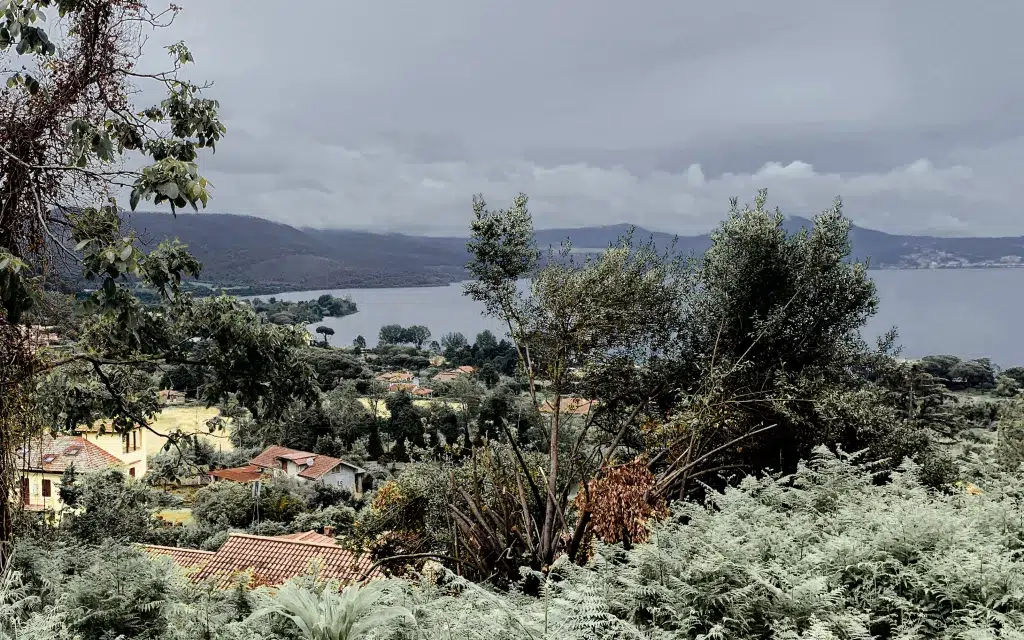
How to Get There from Rome:
Getting there is a piece of cake.
The most convenient mode is by train, which departs from Rome’s Ostiense or Trastevere stations, delivering you to the heart of Bracciano in just about an hour.
Things to See and Do:
Bracciano and its lake offer a range of activities, blending history, nature, and gastronomy:
- Odescalchi Castle: It’s big, grand, and has been around since medieval times. Check it out for a journey back in time and some wow-worthy lake views.
- Stroll Around Lake Bracciano: The lake’s pristine waters invite visitors for leisurely strolls. Whether you’re a die-hard nature lover or just looking for that perfect lakeside selfie, there’s a path with your name on it. Just make sure you pack warm clothes in case it’s a little chilly.
- Lakeside Dining: The towns around Bracciano have a variety of quaint eateries and restaurants. Fancy some fish? Maybe some classic Italian pasta? Or just chilling with gelato? Trust me, with a lakeside sunset backdrop, everything tastes better.
Why Winter is a Good Time to Go:
Lake Bracciano is beautiful in the winter. The winter landscape, with occasional mists hovering over the lake’s surface, offers photographers and artists a unique canvas,
Winter here is like stepping into a painting.
And, if you get a bit nippy, find a cozy corner in a local café, wrap your hands around a warm cappuccino, and take in the view.
Best Day Trips from Rome with Kids:
This Blog is dedicated to family travel and traveling with your children. Here are my recommendations for the top 3-day trips to take in the wintertime with kids.
- Ostia Antica:
- Why it’s Great for Kids: It’s like an open-air museum, allowing kids to explore ancient ruins, streets, and buildings. Playing “pretend” in such an authentic setting will blow their minds.
- Fun Activities: Organize a scavenger hunt or gather around and brainstorm about what life might’ve been like back in the day.
- Tivoli:
- Why it’s Great for Kids: The Villa d’Este, with its many fountains, can fascinate kids. The nearby Hadrian’s Villa also provides vast spaces to run around and explore.
- Challenge the kids to count the fountains at Villa d’Este.
- Lake Bracciano:
- Why it’s Great for Kids: Besides the castle to explore, the lake offers opportunities for outdoor activities.
- Equip them with a birdwatching guide and binoculars, or set them off on a nature-themed scavenger hunt.
Final Thoughts on Day Trips from Rome in Winter
It’s evident that the beauty of Italy in the winter season extends far beyond the confines of its iconic capital Rome.
Embarking on day trips from Rome in winter offers a chance to experience the gorgeous landscapes and less-crowded attractions and provides a deeper understanding of the rich culture that makes up this incredible nation.
So, if winter in Italy is on your European travel itinerary remember that the surrounding regions await your discovery.
Safe travels and warm wishes.

